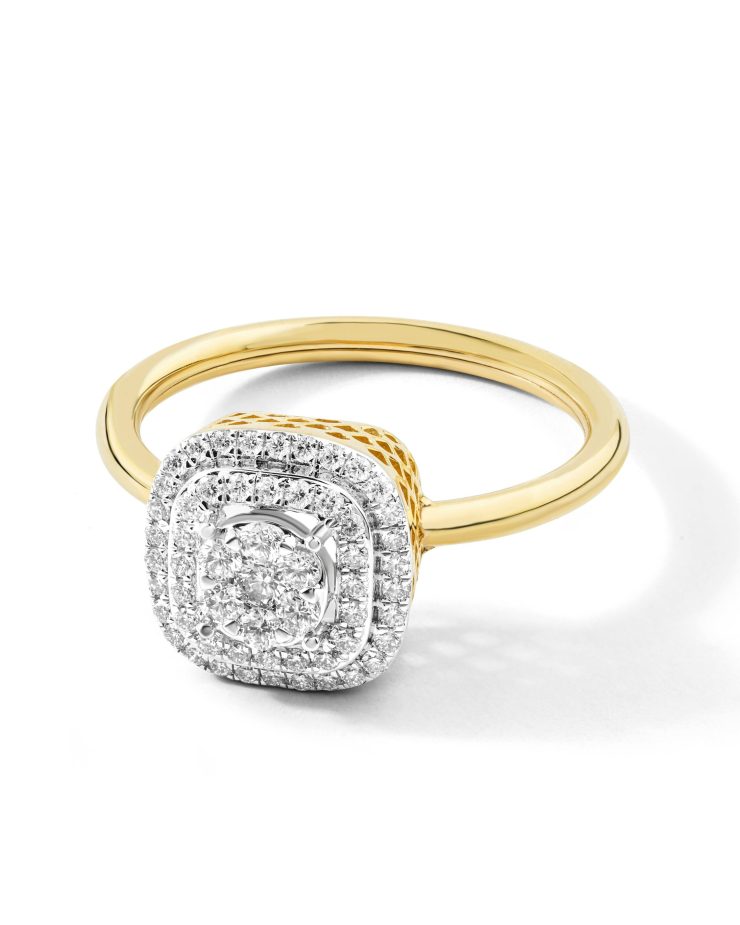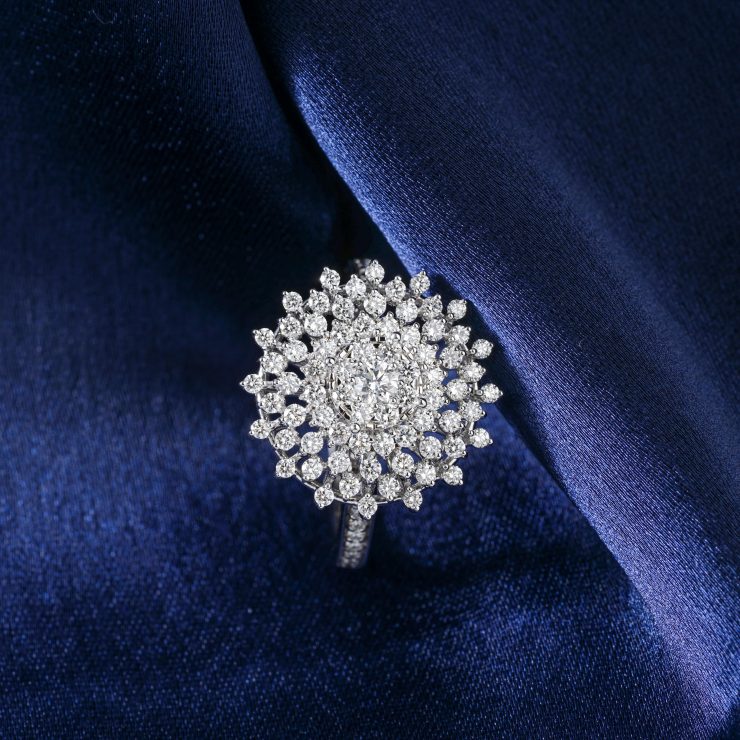Fancy colored diamonds differ significantly from traditional white or colorless diamonds, both in appearance and in value criteria. Unlike white diamonds, which are graded based on the absence of color, fancy colored diamonds are evaluated primarily by the presence and intensity of their color. These diamonds derive their hues from various elements and structural anomalies within the crystal lattice. For example, boron creates blue diamonds, while nitrogen can give rise to yellow or orange tones. Radiation exposure in the Earth can cause green hues, and pressure-related structural deformations may lead to pink or red diamonds. This unique set of geological circumstances makes colored diamonds not only visually captivating but also scientifically intriguing. The Gemological Institute of America (GIA), the leading authority in diamond grading, uses a separate classification system for these gems, further emphasizing their uniqueness. Understanding the science behind their coloration helps buyers appreciate their rarity and complexity, thereby making more informed investment or aesthetic decisions.

The Spectrum of Colors and Their Classification
Fancy colored diamonds come in an array of colors including yellow, brown, pink, blue, green, orange, red, purple, gray, and even black. Some diamonds also exhibit secondary or modifying hues, such as a pink diamond with a purple overtone. The GIA classifies colored diamonds based on hue (the basic color), tone (lightness to darkness), and saturation (intensity). Terms like “Fancy Light,” “Fancy,” “Fancy Intense,” “Fancy Vivid,” “Fancy Deep,” and “Fancy Dark” are used to describe the overall strength and visual appeal of the color. Among these, “Fancy Vivid” is typically the most prized, especially when paired with highly sought-after hues like blue or pink. It’s also important to note that even within the same color group, diamonds can look vastly different due to variations in saturation and tone. For instance, two blue diamonds might differ dramatically if one has a grayish modifier while the other is pure and vivid. This classification system is crucial for understanding a colored diamond’s market value, rarity, and visual appeal.
Rarity and Market Availability
The rarity of a fancy colored diamond significantly impacts both its price and its desirability. Among the rarest are red, blue, and green diamonds. Red diamonds are so scarce that fewer than 30 are known to exist in gem-quality sizes, most of which weigh less than half a carat. Blue diamonds, such as the famous Hope Diamond, owe their color to the presence of boron and are almost exclusively mined in limited regions like South Africa’s Cullinan mine. Green diamonds, while also rare, are especially difficult to find with natural, evenly distributed coloring due to how radiation-induced color can fade during polishing. On the other hand, yellow and brown diamonds are much more common and hence more affordable, making them a popular entry point for those new to the fancy colored diamond market. As natural colored diamonds have become increasingly popular—both for investment and aesthetic reasons—their availability in the market has decreased, contributing to escalating prices and heightened interest among collectors and investors.
Pricing Factors: More Than Just Carat and Cut
The pricing of fancy colored diamonds is influenced by a broader and more complex set of criteria than their colorless counterparts. While carat weight, cut quality, and clarity are still important, color is the single most critical determinant of price. The more vivid and pure the color, the higher the value. A one-carat Fancy Vivid Pink diamond, for instance, can command a significantly higher price than a three-carat Fancy Light Yellow diamond due to its rarity and market demand. In addition to the primary hue, modifying tones and the overall uniformity of color distribution play a major role. Even minor differences in saturation or the presence of grayish or brownish modifiers can substantially affect price. Origin is also a consideration, with diamonds from renowned mines—such as Argyle in Australia, known for pink diamonds—often commanding a premium. Furthermore, treatments such as irradiation or high-pressure high-temperature (HPHT) processing can affect both price and value perception. Natural, untreated stones with gemological certification from a reputable body like the GIA will always be more desirable and valuable.

Investment Potential and Market Trends
Fancy colored diamonds are increasingly viewed as an alternative asset class, appealing to collectors, investors, and high-net-worth individuals seeking to diversify their portfolios. Unlike colorless diamonds, whose value can be more volatile and influenced by larger commercial supply chains, colored diamonds—especially rare hues like pink, blue, and red—have demonstrated consistent value appreciation over time. For example, pink diamonds from the Argyle mine in Australia saw significant price increases year-over-year until the mine’s closure in 2020, after which their value surged due to dwindling supply. Auction houses such as Sotheby’s and Christie’s have regularly reported record-breaking sales for rare colored diamonds, further cementing their status as collectible luxury assets. The market for these gems is also influenced by cultural and celebrity trends, with notable figures opting for colored diamond engagement rings, which boosts demand. However, investment in colored diamonds requires due diligence, especially in evaluating authenticity, treatment status, and market comparables. Buyers should consult diamond investment specialists and ensure any purchase is accompanied by thorough documentation and certification.
Tips for First-Time Buyers
For those new to the world of fancy colored diamonds, making a first purchase can feel daunting due to the complexity and uniqueness of each stone. The most important tip is to prioritize certification. Always buy diamonds graded by reputable laboratories like the GIA, which can verify natural origin, color authenticity, and treatment history. Secondly, educate yourself on the diamond’s hue, tone, and saturation—remember that stronger and purer colors generally equate to higher value. Third, consider the diamond’s cut not just in terms of symmetry or sparkle, but in how well it showcases the stone’s color. Some cuts, like cushions and radiants, are particularly effective at enhancing color. Budget is also a key consideration; while pinks and blues may be beyond reach for some, vibrant yellow or champagne-colored diamonds can offer a stunning appearance at a more accessible price point. Lastly, work with dealers or jewelers who specialize in colored diamonds, as they can provide insights into trends, value, and available inventory that general retailers may not have.
Importance of Certification and Authenticity
Certification is a cornerstone in the process of buying any fine gemstone, but it becomes even more crucial when dealing with fancy colored diamonds. These diamonds can be subject to a range of treatments intended to enhance their appearance, such as irradiation, HPHT, or coating. While these treated diamonds are still beautiful, they do not carry the same value as natural, untreated stones. Therefore, a grading report from a recognized laboratory—most notably the Gemological Institute of America (GIA)—is indispensable. The GIA provides a Colored Diamond Grading Report that outlines the diamond’s color origin (natural vs. treated), color grade, and clarity. Some reports even include a plotted diagram of the diamond’s inclusions and a photograph, offering transparency and aiding resale. Other reliable labs include the IGI (International Gemological Institute) and AGS (American Gem Society), though GIA is most widely trusted for colored stones. Always verify the certificate’s authenticity with the issuing lab’s online database and avoid purchasing colored diamonds without professional documentation.
Final Considerations Before Purchase
Before making a final decision to purchase a fancy colored diamond, consider your goals—whether you’re buying for personal enjoyment, as a collector, or for investment purposes. These goals can influence everything from your budget to your color choice. For aesthetic purposes, you may favor a particular hue that resonates emotionally, regardless of its rarity. Investors, however, may lean toward diamonds with a proven track record of appreciation, such as Fancy Vivid Pinks or Blues. Also, be wary of synthetic or lab-created colored diamonds if your goal is long-term value retention; while they can look stunning and cost significantly less, their resale value and collectibility are limited. Another consideration is setting and jewelry design: the right mounting can enhance the appearance of a colored diamond, emphasizing or complementing its tone. It’s also worth exploring auctions and estate sales, which occasionally present rare colored diamonds not found in traditional retail channels. As with any high-value purchase, patience, research, and expert consultation will yield the best outcome.